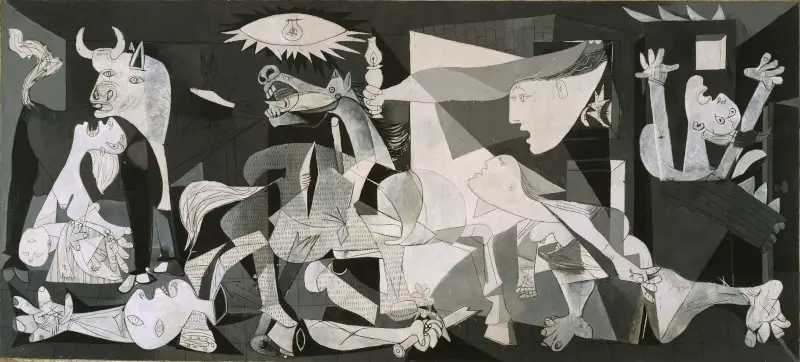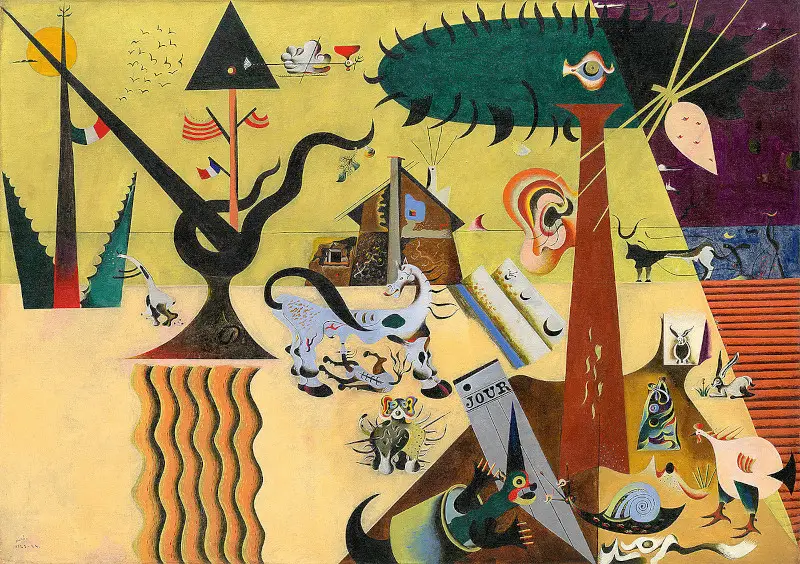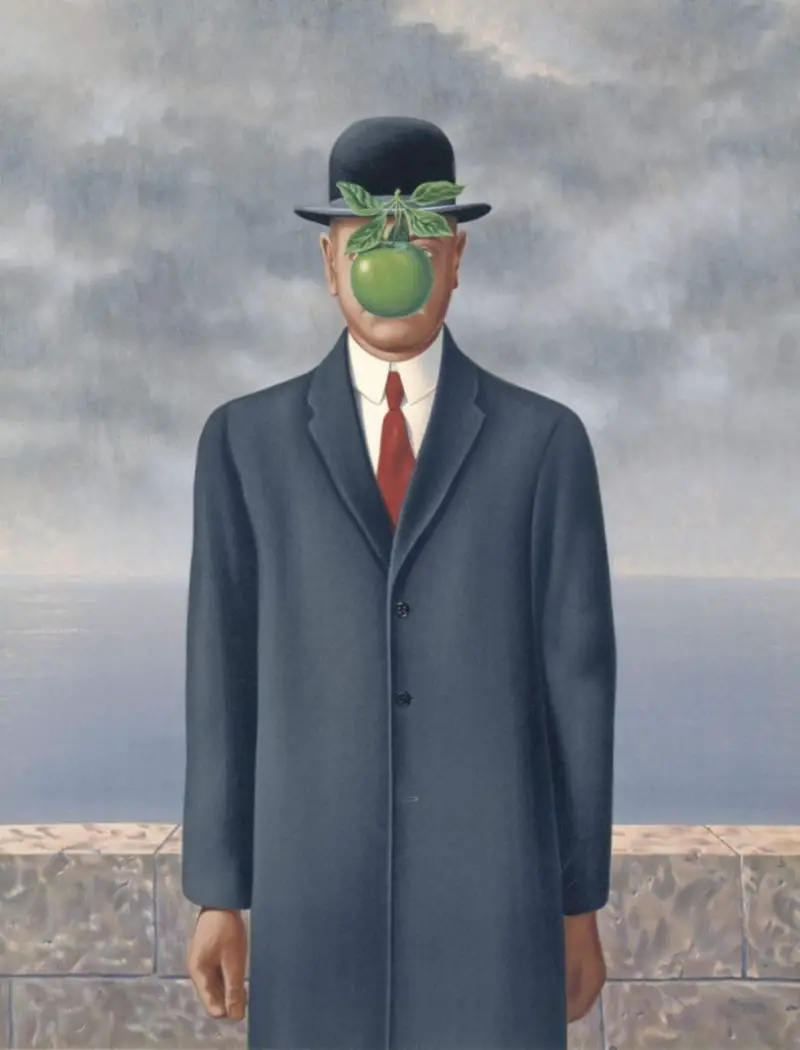 Buy Art Prints Now
Buy Art Prints Nowfrom Amazon
* As an Amazon Associate, and partner with Google Adsense and Ezoic, I earn from qualifying purchases.
Discover the most famous Surrealist artists, including painters and sculptors from the early to mid 20th century.
Introduction to Surrealism Art
Surrealism art was a innovative and significant 20th century art movement which brought dreams and the subconscious mind into art. Typically, Surrealism artists would capture elements from reality but combine them in unusual ways, just as we experience in our dreams and nightmares. Certain elements and approaches were consistent across different artist's careers, and many of the names below were well known to each other as part of artist groups.
Much thought and planning went into the Surrealism art movement, which had its own manifesto that many artists broadly supported. Over time, these ideas would be taken into many different art forms, embracing the new opportunities that fell to artists in the 20th century. Beyond painting, drawing and sculpture, Surrealism would also impact film, photography, literature and theatre.
List of Famous Surrealism Artists
The list below is a short selection of the most famous Surrealism artists, but in truth there were many other notable figures who contributed to this important art movement. Indeed, even after the impact of these great names, others would continue in a similar style in later generations, helping to keep the movement evolving up to the present day.
Most of the names listed here specialised in Surrealism and rarely tackled any other styles across their oeuvres, but some were only briefly involved and soon moved on. The early to mid 20th century brought a wealth of opportunities, including Cubism, Expressionism, Abstract art and much more, which the likes of Picasso could not resist dipping into at various points in their career.
Salvador Dalí
Salvador Dali was the most famous Surrealist of them all, and his paintings are remembered for their use of melting clocks, barren landscapes inspired by his childhood in Spain, as well as distorted figures. Dali was a larger than life character whose personality helped him to build something of a celebrity status. Some of his iconography could then be translated into commercial products and this productive artist was never shy of trying out new avenues of artistic expression.
The artist experimented with a variety of artistic styles early in his development, including Cubism and Impressionism. Whilst he mastered these methods, he wanted to be a little more avant garde, and so joined a young collective who were to form the Surrealist movement. His use of the paranoiac-critical method let to iconic works such as The Persistence of Memory, whilst he also drew on influence from past movements, such as the elongated forms in Elephants, which remind many of the work of El Greco.
Items such as eggs and bees would become regular features in Dali's work, bringing a consistency to his elaborate and bizarre imagery. Colors were also bright in most cases, inspired by the bright light he experienced in growing up in Spain. His talents would later be spread into jewelry, which linked perfectly with his melting clocks from a number of paintings.
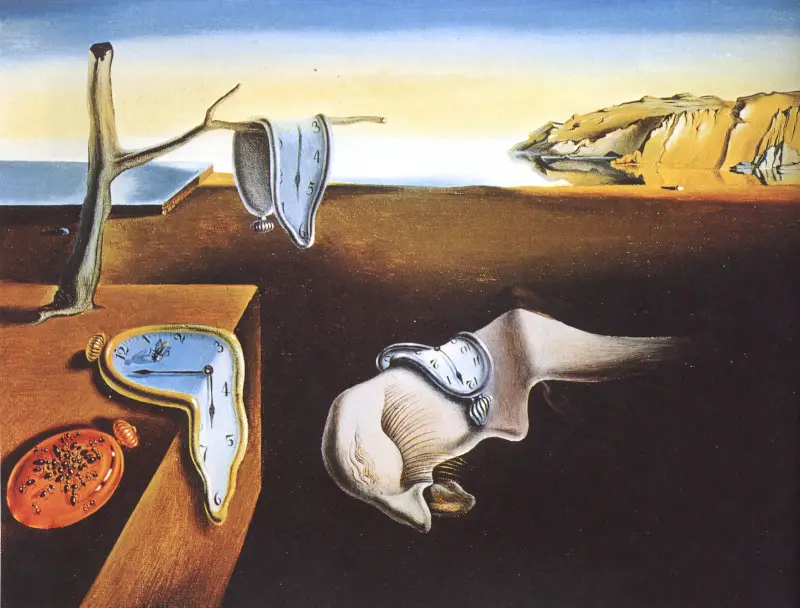 The Persistence of Memory - Famous Surrealist Painting by Salvador Dali
The Persistence of Memory - Famous Surrealist Painting by Salvador Dali
René Magritte
René Magritte was a Belgian Surrealist who become most famous for his Son of Man artwork which even the most casual of art fan would instantly recognise. He attempted to provoke thought in the viewer by re-arranging every day objects into unusual combinations, though this was a common theme throughout the entire movement. Magritte loved to play with an object and its visual appearance, almost predicting elements of digital art that followed decades later.
Much of Magritte's imagery was highly contemporary and has been used across multiple mediums more recently. Film and theatre has celebrated his work extensively, and he remains one of the most famous Surrealist artists. Many of his works also featured text, which helped to get across his message in a deeper, clearer manner than if he had just relied on his system of icons. Rene Magritte paintings continue to remain as amongst the highlights of the entire movement, with The Treachery of Images being another significant highlight, and an example of his use of text with simple imagery.
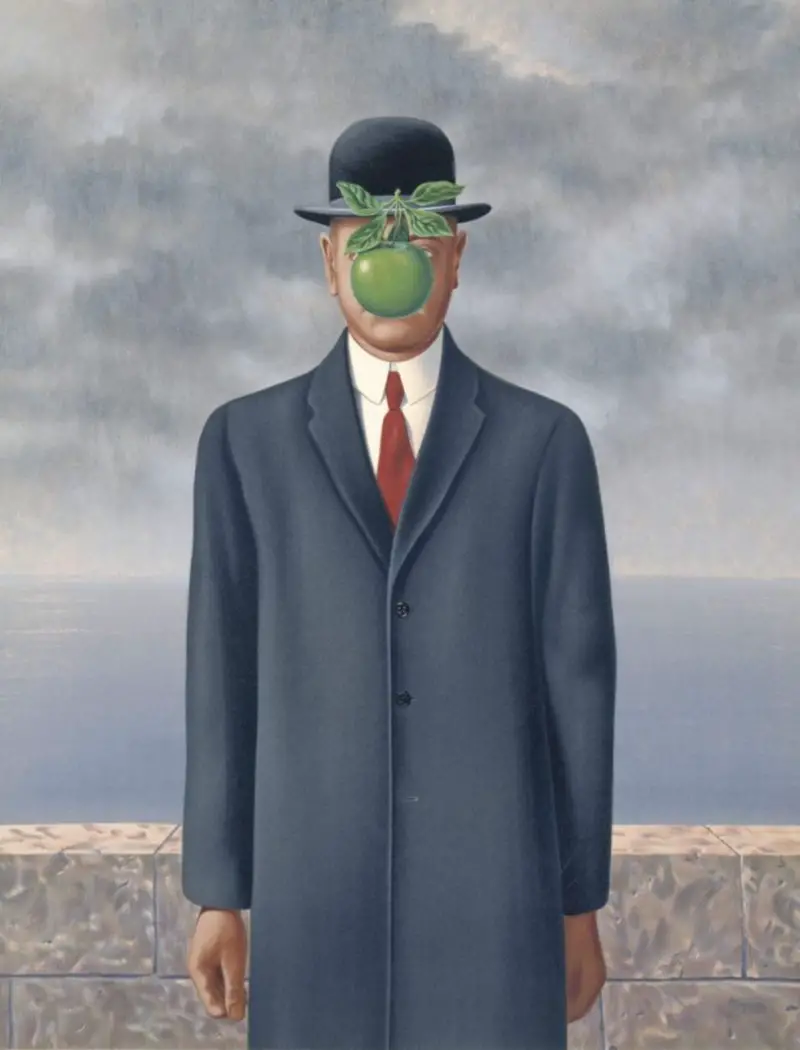 Son of Man Rene Magritte Surrealist Painting
Son of Man Rene Magritte Surrealist Painting
Max Ernst
Max Ernst excited the world with classic Surrealist artworks such as The Elephant Celebes, Ubu Imperator and Forest and Dove. Ernst went beyond re-arranging reality and actually producing creatures from his own imagination, in the contemporary version of Bosch's Garden of Earthly Delights. He mainly relied on two-dimensional landscapes, with arrays of fantastical imagery placed across the foreground.
Magritte worked in the Dada style after earlier embracing the Impressionist and Fauvist approaches. He was also known for his use of collages, perhaps becoming the most famous artist who used this method so frequently. Indeed, his fame for collage art would herald several terms being coined, based on his work, such as frottage and grattage. Ernst was impacted by his experiences in WWI, as well as a growing interest in psychoanalysis and the theories of Sigmund Freud.
Freud became a major influence on many members of the Surrealist movement, and this was an important moment in the development of western art, where the mind was being examined in much greater depth than seen before. Previously, it was more about conscious emotions, and reflecting those within art, as seen in Romanticism with the likes of Delacroix and Turner, Expressionists such as Munch and Post Impressionist artists like Van Gogh.
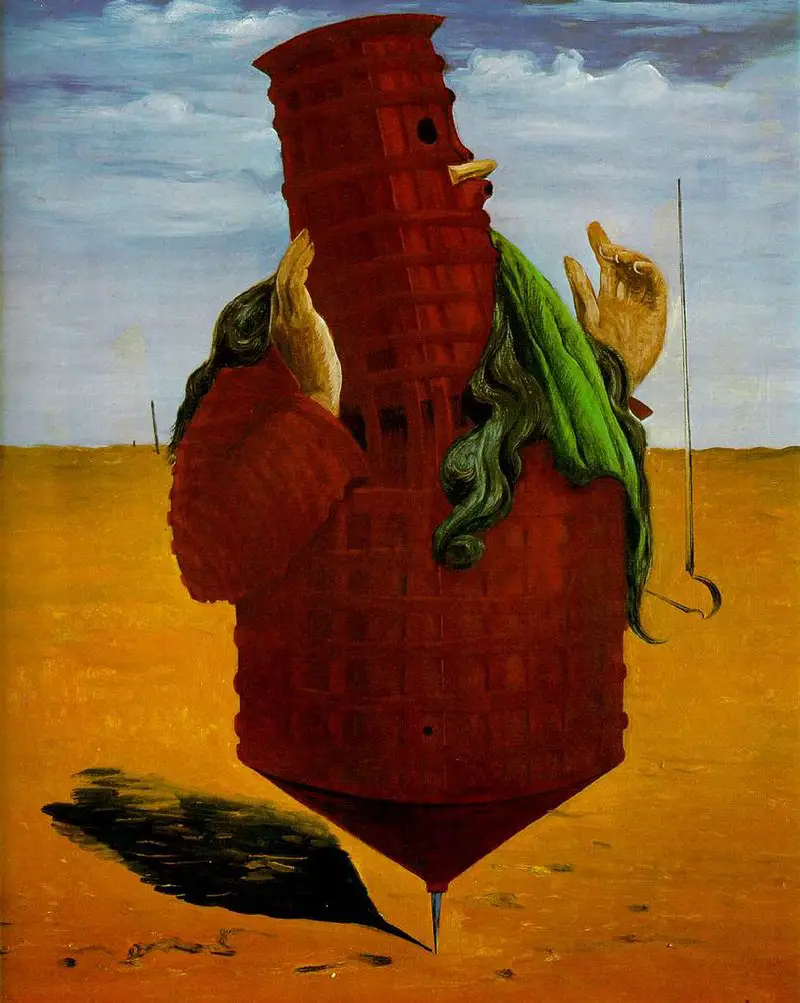 Ubu Imperator by Famous Surrealist Artist, Max Ernst
Ubu Imperator by Famous Surrealist Artist, Max Ernst
Frida Kahlo
Frida Kahlo used her art to express the inner turmoil in her mind which had resulted from a series of unfortunate events. An accident in her childhood had led to persistent health issues, and turbulent relationships would regularly unsettle the young Mexican artist. Self portraits dominated her oeuvre, and allow us to visually see the impact of these events. Many of the items that she added around her paintings were reminders of her Mexican roots, including her pets and luscious fruit.
Kahlo was eventually able to travel outside of Mexico and despite her aversion to capitalism, she travelled to the US where she worked and exhibited alongside her husband, Diego Rivera. She remained a committed Communist and Socialist throughout her life, becoming something of an activist in later life. Her paintings have achieved an iconic status today, in part due to the difficulties that she overcame across her life.
Kahlo is today regarded as the most famous female painter in history, with her reputation rising considerably in recent years. Her image has been reproduced in all manner of different guises, and many see her as a true feminist icon. Kahlo can be considered a true Surrealist, but also someone who worked independently of her European counterparts, leaving behind a rich and pure oeuvre.
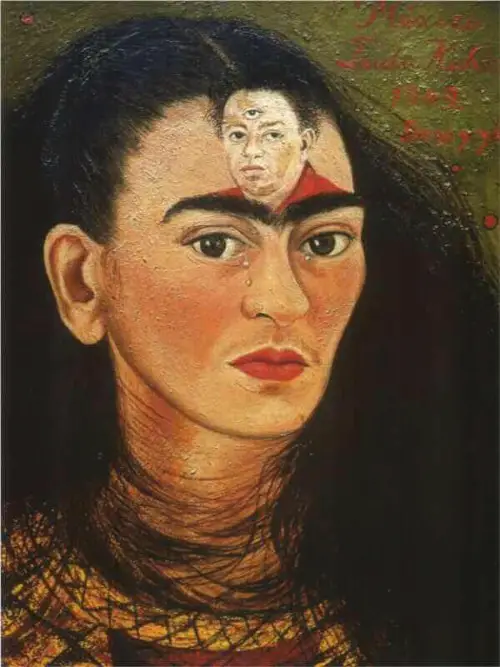 Diego and I by Frida Kahlo - Famous Surrealist Female Painter
Diego and I by Frida Kahlo - Famous Surrealist Female Painter
Pablo Picasso
Picasso was heavily linked to the Surrealist movement during the 1920s and 1930s, though his focus on a multitude of different styles across his career has made it impossible to label him other than as an artistic genius. He took on Surrealism poetry for a period, and certainly drew influence into his paintings from the major Surrealists of his time. There was also a crossover in his work, merging elements of different styles.
His iconic Guernica, for example, bears the hallmarks of both Cubism and Surrealism. Within this scene he depicts the horrors of war, showing all manner of items in a small vilage just after it has been bombed to obliteration. The painting is in a two dimensional format and varies widely from other Surrealist landscapes, though with considerable qualities of its own. Picasso was an artist who would throw himself into a movement for a short period, before then quickly moving on, though potentially taking some of his discoveries with him onto the next stage of his career.
Joan Miro
Joan Miro experimented with multiple styles across his career, though he can be described as focusing on Surrealism in much of his oeuvre. This Spanish artist created a series of symbols that he would use across his works, and eventually translate these into Surrealist sculptures as well. He made use of bright colors inspired by life in Spain, just as Dali would do, and his dreamy imagery would also cross over with the rise in abstract art. His simplistic style was suited to cross-mediums, and he would become one of the most famous and much loved artists of the 20th century.
The sky would hold many of his favorite inspirations, with birds and constellations being repeatedly used, often combined with simple lines and arrows. Rather than making use of dreams, this was an artist who reduced himself to a child-like simplicity, which required much more skill to achieve than one might understand. Picasso is known to have admired this approach, and practiced for years in order to achieve a similar look to his own work, most noticeably in his line drawings.
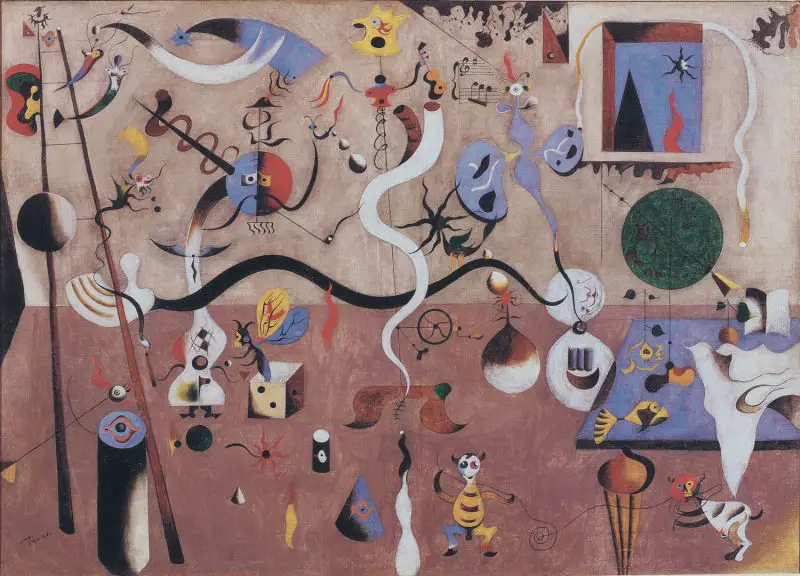 Harlequins Carnival by Joan Miro
Harlequins Carnival by Joan Miro
André Breton
André Breton was an important member of the Surrealism movement who pushed for automation within art, with the hope of bringing an element of randomness and chance into mainstream art. Surrealist drawing involved continuing one drawing into the next, but hiding most of the preceding work, ultimately leading to long series of unrelated sketches which allowed artists to work without thinking. Breton was one of the more deep-thinking members of the group and wrote a number of publications which shed light on the thinking behind these extraordinary works.
Breton was an organising figure within the group, helping to not only put together a manifesto to lay out a direction for their work, but also to arrange meetings and exhibitions that helped to build momentum for this avant garde group of artists. Breton became a vocal left wing activist as his life developed, and spent time pushing this agenda, alongside his art career.
Leonora Carrington
Leonora Carrington was a Mexican Surrealist artist, born in the UK. She arrived late into the movement, but is best known by some for having a romantic relationship with fellow artist, Max Ernst. Her major works would start to appear from the late 1930s, onwards, and were regularly filled with extraordinary detail, with each piece being carefully crafted and considered. This creative woman who worked as a writer too, and Surrealism was always a group which encouraged its members to look beyond just the visual arts.
Man Ray
Man Ray was an important American modern artist who worked alongside Dali and Breton. Ray was another mixed discipline artist who specialised in photography, but also worked with painting, sculpture, filmmaking, and assemblage across his career. He may well have influenced other members of the group with his technical prowess in photography, and also learnt from them about painting and sculpture art in return. He also helped to link the group to the US, which was a nation that would eventually lead western art by the end of the 20th century.
Yves Tanguy
Yves Tanguy was famed for his surrealist landscapes which beared a resemblance to the work of Magritte, Dali and Ernst, but with some of his own ideas applied on top. His elaborate objects that were placed around his barren landscapes resembled life in outer space, or from our own dreams or fantasies, with many creations being hard to link to much from the real world. He was familiar with other members of the group, and remains regarded as a key contributor to the movement.
The Early Influences: Freud, Dada, and the Birth of Surrealism
A number of different influences would combine to bring about the Surrealist movement in the early 20th century. There was a growing interest in the subconscious mind, with Sigmund Freud's theories being of particular interest to a number of artists. The Dada movement were also seeking to reject traditional art methods and create an entirely new environment for artists to flourish, and they were far from the only ones to be doing this.
Sigmund Freud was the founder of psychoanalysis and delved deeply into the mind, discovering more about how hidden fears and desires might impact our behaviour and he also analysed common dreams in detail. His discoveries and musings would herald new ideas within the art world, as artists sought to expand upon his theories in the visual world, with all sorts of exciting opportunities to be found once artists moved away from reality.
One method that was used to connect to the subconscious mind was through automated art, where artworks would be created without any conscious thought, thereby accessing other parts of the brain, or so the theory went. This could be achieved by passing around papers, and continuing onwards from what had gone before, but whilst having most of it covered up.
Many artists in the early 20th century believed that whilst techniques had vastly improved in the preceding centuries, there had been too great a focus on depicting reality, leaving a huge area of imagination and creativity left completely untapped. They would set about forming the Surrealist group and promoting their ideas in order to open up new opportunities to artists around the world, including themselves.
Surrealist Techniques: Unleashing the Power of the Unconscious
A number of artistic techniques appeared within the Surrealist movement as a means to accessing and unleashing the power of the unconscious mind. Automated drawing was amongst the best known, where paper would be passed around and artists would take turns to create their own iteration (Exquisite Corpse), unaware of what had gone before, or what would follow, until the entirely process was complete.
There would also be different types of collage, some of which was invented by Max Ernst, who favored this approach. Frottage and Grattage also appeared, where natural elements would be used and wet paint scraped off to create all manner of different effects. Decalcomania brought an element of random chance into painting, which was another aspect of Surrealism, where no artwork would ever be the same as the next.
Photography also specifically saw advancements, including double exposures and photomontage as this art form would start to see greater experimentation and innovation. Before that, photographers had mainly relied on technological advancements, rather than their own creativity, but many new ideas would now flood into the discipline right across the 20th century.
Surrealist Painting: From Dreamscapes to Bizarre Realities
Surrealist Painting often captured bizarre landscapes, with imagery that was partly inspired by their own experiences, and partly from their imagination. Many of the creatures found within these landscapes would be fantastical, akin to the creatures of Hieronymus Bosch. Each artist would have their own style within that, and Dali by contrast would often re-use items from reality instead.
Dali's approach was more about re-arranging reality, with bees and melting clocks, where as others would create brand new environments which remind us of a space-like barren world. There would also be collaborative work, most commonly in Surrealism drawing, where simple sketches could be handed around and a collective artwork produced in a single sitting. These were fun and informal moments in time, bringing elements of chance to each unique piece.
The Role of Automatism: Surrealist Writing and Poetry
Automatism would be extended into writing and poetry, bringing a new body of work to these disciplines. There was a desire to learn more about the untapped parts of the brain, and new techniques would be needed in order to access it. It was felt that existing techniques had gone as far as they could go, and new ideas were necessary in order to keep literature, poetry and the visual arts as fresh as possible. Surrealist writers, such as André Breton, Salvador Dalí, and René Char, would try out deep meditation as a means to entering this new world.
The process that followed allowed unstructured musings to appear, with a full flexibility of what an artist might write during the creative process, in a similar manner to a brainstorming session. Writers would also work collaboratively, allowing poetry to jump from one mind to the next, with as little direction as possible, in order to avoid controlling these thoughts. Many of the Surrealist poets were also draughtsman or painters, and so inevitably a visual experimentation would occur with their writings as they tried all manner of fonts, as well as displaying text in a highly informal, unstructured manner.
Surrealist Sculpture: Objects from the Unconscious Mind
The most significant change brought about by Surrealist sculpture was in the use of all manner of different objects within the artworks. Previously, marble and bronze had been the dominant mediums, but Surrealist sculpture opened the door to natural objects found strewn across the countryside, as well as other everyday, manmade objects. We would see similar in mixed media painting, such as with Cubism, where stones, newspapers, sand and tree bark could potentially appear.
The sculptors would attempt to produce similar themes to the Surrealist painters, but use natural items to create them. In a way, these random choices suited the dream-like content of the entire movement, with some choosing to re-arrange elements that we are familiar with, but into formats that are entirely alien to us. Dali would tackle most avenues into which the Surrealists ran, including literature, sculpture, drawing and painting. Marcel Duchamp was a famous Surrealist sculptor who shocked and excited his audience with bizarre, but brilliant choices.
Surrealist Photography: Capturing the Marvels of the Subconscious
Photography became an experimental medium during the Surrealist era, making considerable alterations to composition, perspective and scale to create different effects within their work. They attempted to explore psycho-analytic theories through their work, and from a technical sesne would make use of double exposures, multiple exposures, or photomontage in order to do so - photography would never be the same. Light and shadow would also be used for different effects, taking from the great Renaissance masters of the past.
Photography was perfect for the application of chance within art, and this element of the random was common in the Surrealist movement. The inclusion of photography as a major element to their body of work immediately positioned the Surrealists as unique within European visual art history, when compared to the previous art movements of the past and helped to establish photography as a discipline to admire and take seriously.
Surrealist Film: Exploring Dreams and Desires on the Silver Screen
In a similar manner to literature and poetry, Surrealist film makers like Luis Buñuel, Salvador Dalí, and Jean Cocteau would attempt to re-invent the discipline by breaking away from conventional patterns. In a similar manner to the opportunities that sculpture brings to painters, the animated nature of film allows artists many new avenues of expression. Surrealist films could be disorientating, and would be highly theatrical, and quirky. Many would be left confused, seemingly unprepared for the mind explorations that these films represented.
Film makers would edit in unusual ways, and also take many of the changes made in painting and sculpture into this art form. Barren landscapes with bizarre creatures were translated directly from large, atmospheric oil paintings across to a series of films. Many of the collage effects could also be used in this discipline as well. Symbolism was often used to represent some of the different emotions that film makers were attempting to replicate.
Surrealism in Literature: Magical Realism and Beyond
Magical realism is connected to Latin American literature and would have been influenced by Surrealism. They would combine elements of fantasy with reality and contributors to this included Gabriel Garcia Marquez, Isabel Allende, and Jorge Luis Borges, who helped to spread the impact of Surrealism way beyond Europe's boundaries. Literature would also enter political activism which was also found in Surrealism, with many of its members being on the left, politically.
List of the Most Famous Surrealism Paintings
Find below a list of the most famous Surrealism paintings, covering the breadth of the movement, and a number of different artists. All of the major names are included here, including Miro, Dali, Kahlo, Ernst and Magritte, and the full list provides an excellent overview of the types of style and content found within the Surrealist art movement. Those looking to go beyond these artworks, might consider looking deeper into our list of famous Surrealist artists elsewhere in the article, and browsing more of their work, individually.
- The Persistence of Memory by Salvador Dali
- Dream Caused by the Flight of a Bee Around a Pomegranate a Second Before Awakening by Salvador Dali
- The Temptation of St Anthony by Salvador Dali
- Elephants by Salvador Dali
- The Son of Man by Rene Magritte
- The Treachery of Images by Rene Magritte
- The False Mirror by Rene Magritte
- The Elephant Celebesby Max Ernst
- Ubu Imperatorby Max Ernst
- Forest and Dove by Max Ernst
- The Tilled Field by Joan Miro
- Harlequin's Carnival by Joan Miro
- The Hunter (Catalan Landscape) by Joan Miro
- Diego and I by Frida Kahlo
- The Wounded Deer by Frida Kahlo
- The Broken Column by Frida Kahlo
Surrealism Rediscovered: Current Trends and Revivals in Art
The unconscious mind remains relatively undiscovered and in recent years that has been a renewed interest in the Surrealist artists, and the type of art that they produced. Could the next wave of Surrealists potentially delve even deeper into our minds? Digital technology potentially allows them new opportunities, with AI able to merge and expand on our reality with ease. All sorts of ideas can be generated and explored in minutes, bringing Surrealist art to anyone with access to a computer. Naturally, this would not be treated as technically impressive, but the topic of exploring imagination is now relevant to everyone.
Indeed, modern art has allowed a full breadth of ideas to be explored, and even mainstream art voices now encourage such wild expression. Photography has also continued to evolve over time, with new techniques aided by improved software editing opportunities. Surrealism has also become a global movement, allowing non-Europeans to bring new ideas into the fold for the first time.



